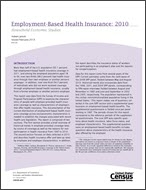Employment-Based Health Insurance: 2010
Employment-Based Health Insurance: 2010
Introduction
More than half of the U.S. population (55.1 percent) had employment-based health insurance coverage in 2011, and among the employed population aged 18 to 64, over two-thirds (68.2 percent) had health insurance through their own employer or another person’s employer.1 In addition, over one-third (34.7 percent) of individuals who did not work received coverage through employment-based health insurance, usually from a former employer or another person’s employer.
This report uses data from the Survey of Income and Program Participation (SIPP) to examine the characteristics of people with employer-provided health insurance coverage as well as characteristics of employers that offer health insurance. This documentation of the current distribution of employment-based health insurance coverage across socioeconomic characteristics is needed to establish the changes associated with recent health care legislation. The report is composed of two sections. The first section provides a brief overview of historical trends in employer-provided coverage rates by source of coverage as well as the reasons for non-participation in health insurance from 1997 to 2010. The second section focuses on data collected in 2010 and describes health insurance offer and take-up rates by employee and employer characteristics. In addition, the report describes the insurance status of workers not participating in an employer’s plan and the reasons for nonparticipation.
Data for this report come from several years of the SIPP. Current estimates come from the sixth wave of the 2008 SIPP panel, fielded between May and August 2010. Historical trends also incorporate data from the 1996, 2001, and 2004 SIPP panels, corresponding to fifth-wave interviews fielded between August and November in 1997 and June and September in 2002 and 2005, respectively. The population represented is the civilian noninstitutionalized population living in the United States.2 This report makes use of questions collected in the core SIPP section and a supplemental questionnaire on employment-based health benefits. The supplemental questionnaire is fielded once per panel starting in 1997. The periods chosen for this report correspond to the reference periods of the supplemental questionnaire. The core SIPP asks specific questions about health insurance, labor force status, and employer characteristics. The supplemental questionnaire on employment-based health benefits includes questions about characteristics of the health insurance plan offered by the employer.
This report builds on earlier work by Bhandari and Fronstin.3,4 In particular, this work is an update of an earlier report by Bhandari, “Employment-Based Health Insurance: 1997.” Fronstin details trends in coverage, take-up rates, and reasons for nonparticipation in employment-based health insurance between 1997 and 2010. While the work is restricted to workers aged 18 and 64, it provides an excellent overview of changes in the distribution of employer-provided coverage for this demographic over this period. This report differentiates itself from Fronstin’s work by expanding the population universe to include unemployed individuals and those not in the labor force for ages 15 and above. A detailed analysis of employer-provided health insurance across labor force status is valuable, since the Patient Protection and Affordable Care Act is likely to change incentives for both employers and individuals in these groups (i.e., employed, unemployed, and not in the labor force) to obtain coverage through employment-based sources.5
The economic and demographic characteristics studied in this report include sex, race and ethnicity, age, family income, and insurance status. Race and ethnicity is defined throughout the report in terms of the four following mutually exclusive categories: (1) non-Hispanic White, (2) non-Hispanic Black, (3) Hispanic, and (4) non-Hispanic Other. Statistics for the non-Hispanic Other category are not included in this report.6 The primary measure of family income used in this study is an individual’s total family income as a percentage of their poverty threshold. A value less than one hundred percent indicates that an individual is considered in poverty as defined by the Federal Poverty Thresholds. Health insurance status is presented in the following categories: (1) employment-based (or union-based) health insurance coverage; (2) direct-purchase or military-related health insurance and no employment-based coverage; (3) public coverage, and no employment-based or direct-purchase or military-related coverage; and (4) no health insurance coverage. This means that those with more than one type of insurance including employment-based insurance are included in the employment-based group. The direct-purchase or military-related health insurance category includes respondents with mixed coverage from public health insurance sources. Finally, measures of offer rates refer to whether the employer offers health insurance benefits to any of its employees.
_______________
1 DeNavas-Walt, Carmen, Bernadette D. Proctor, and Jessica C. Smith, “Income, Poverty, and Health Insurance Coverage in the United States: 2011,” Current Population Reports, P60-243, U.S. Census Bureau, Washington, DC, 2012.
2 The estimates in this report (which may be shown in text, figures, and tables) are based on responses from a sample of the population and may vary from the actual values because of sampling variability or other factors. As a result, apparent differences between the estimates for two or more groups may not be statistically significant. All comparative statements have undergone statistical testing and are significant at the 90 percent confidence level unless otherwise noted.
3 Bhandari, Shailesh, “Employment-Based Health Insurance: 1997,” Current Population Reports, P70-81, U.S. Census Bureau, Washington, DC, 2002.
4 Fronstin, Paul, “Employment-Based Health Benefits: Trends in Access and Coverage, 1997–2010,” EBRI Issue Brief no. 370, Employee Benefit Research Institute, 2011.
5 Congressional Budget Office, “Estimates for the Insurance Coverage Provisions of the Affordable Care Act Updated for the Recent Supreme Court Decision,” July 2012.
6 “Non-Hispanic Other” refers to people who are not Hispanic and reported Asian alone, Pacific Islander alone, American Indian alone, Alaskan Native alone, or multiple races.
Others in Series
Publication
Publication
Publication







